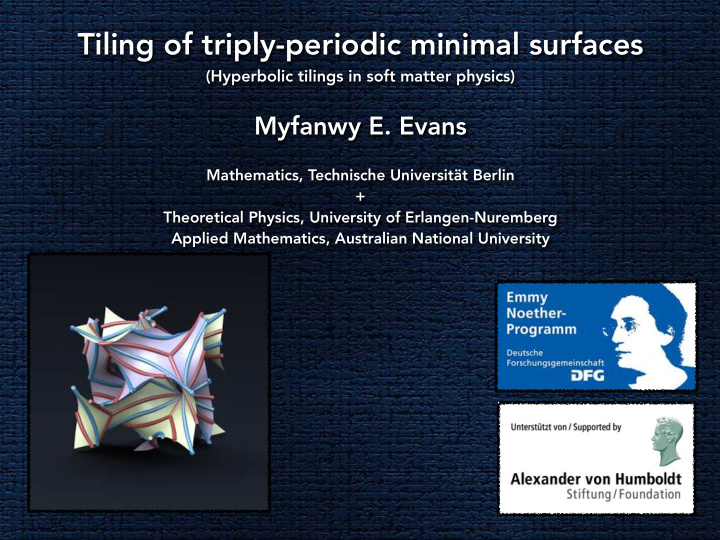



Tiling of triply-periodic minimal surfaces (Hyperbolic tilings in soft matter physics) Myfanwy E. Evans Mathematics, Technische Universität Berlin + Theoretical Physics, University of Erlangen-Nuremberg Applied Mathematics, Australian National University
TPMS: Primitive, Diamond and Gyroid
Bicontinuous form in-vivo Sea urchin skeleton Mitochondria of amoeba Keratin structure of skin Porous chitin in butterfly wing scales Inner-cellular membranes Pro-lamellar body (endoplastic reticulum) (chloroplsat precursor)
Surface tension favours bilayer structure (membrane) Smaller headgroups Bulky interior Smaller headgroups
Local Gaussian curvature distribution over the Gyroid minimal surface
The 2D hyperbolic plane is the universal cover of the P , D and G minimal surfaces. The *246 tiles are the smallest asymmetric patch of the minimal surfaces.
credit: Stuart Ramsden, ANU
EPINET: epinet.anu.edu.au (Euclidean patterns in non-Euclidean tilings) Tilings as 3D networks. Large scale enumeration and structure database. Uses Delaney-Dress tiling theory to enumerate structure of use to chemistry as well as other natural sciences. Sodalite: Na 8 (Al 6 Si 6 O 24 )Cl 2 (a zeolite)
EPINET: epinet.anu.edu.au (Euclidean patterns in non-Euclidean tilings)
Line and tree packings Free tilings can be enumerated if we consider them as closed tilings with edges symmetrically deleted.
Extension of Delaney-Dress tiling theory: Free Tilings
3D “weavings” from 2D line packings. The simplest line packings build rod packings, well known in structural chemistry and the study of metal organic frameworks.
The tree packings, or forests, can also be transferred to the minimal surfaces, here to the Gyroid. The resulting structures are multiple inter- threaded networks. The structure inherits specific edge geometry, rather than simply topology.
When tree-like objects are packed in the hyperbolic plane, the resulting structures in 3D are more complicated. The tree objects become networks in 3d space, and depending on how edges meet up, the number of networks interthreading each other can be many (in same cases up to 64 networks sitting within each other). A complete characterisation of the way that these structures interthread is still yet to be determined.
These two structures on the Gyroid both give two inter-threaded srs nets, with curvilinear edges. The geometry is inherited from the surface tiling, and in this case, the structures are not equivalent to each other, despite having equivalent topology.
Degree-4 and degree-6 forests form multiple components of diamond nets and primitive cubic nets in 3D space respectively.
A further nice example, where the 3D structure is a beautiful interweaving of graphite nets, or honeycomb (hcb).
2223 Symmetry (Orbifold notation)
Varying the helical pitch
(2,1) (3,1) (3,2) (4,1) Evans et al. 2013, Acta Cryst, A69, 241-261
Block copolymer self-assembly
What about TER-block copolymer self-assembly? Model three-phase star copolymers, during self assembly via a coarse-grained simulation, separate into a hierarchical structure with two gyroid channels and a hyperbolic membrane. The membrane segregates further into “hyperbolic lamellae”.
3 5 15 53 99 195 675 725 x x=1.75 x=3.66 x=7 Adjusting the relative length of C/D to A/B, three distinct hyperbolic striping patterns emerge, which we can categorise precisely from our theory of hyperbolic packing. The ideal mesostructures of these patterns in three-dimensional space are spectacular and among the most complex self-assemblies identified to date. It shows that our ideas of hyperbolic packing are physically relevant. Kirkensgaard et al, PNAS (2014)
3D “weavings” from 2D line packings. The simplest line packings build rod packings, well known in structural chemistry and the study of metal organic frameworks.
Given rotational symmetry, rather than mirror symmetry, we can pack the helices in an infinite number of distinct ways. A systematic enumeration of these is given in Evans et al. 2013, Acta Cryst, A69, 262-275, using Delaney-Dress tiling theory and geometric proofs.
More complicated hyperbolic packings give more woven filament packings in 3D space. The filaments are sufficiently tangled to prohibit straightening. Topologically, there is very little we can say about the structures. A key questions to answer would be, How can we tell if two weavings are ambient isotopic to each other? Evans et al. 2013, Acta Cryst, A69, 262-275
Energy minimising geometry A canonical configuration of a structure as a way of identifying the geometric embedding. These minimise the ratio of length to diameter per unit cell. A well established concept for finite knots.
Some ideal conformations of triply-periodic braids Evans, Robins & Hyde, submitted (2015)
Auxetic-like? Dilatant Weavings... In the ideal configuration, the filaments are helical in shape. Cooperative straightening induces an expansion of the material. We call this property “dilatancy”, and it is somewhat reminiscent of Auxetic materials, however the exact relation is yet to be established. Evans & Hyde 2011, J. R. Soc. Interface, 8, 1274–1280
The ∑ + packing also has a dilatant property, and the expansion here is larger. All dilatant structures that we have identified so far are chiral.
Perspective: Increase vertex or edge transitivity of the tilings Decrease symmetry Explore woven patterns as real materials
Recommend
More recommend